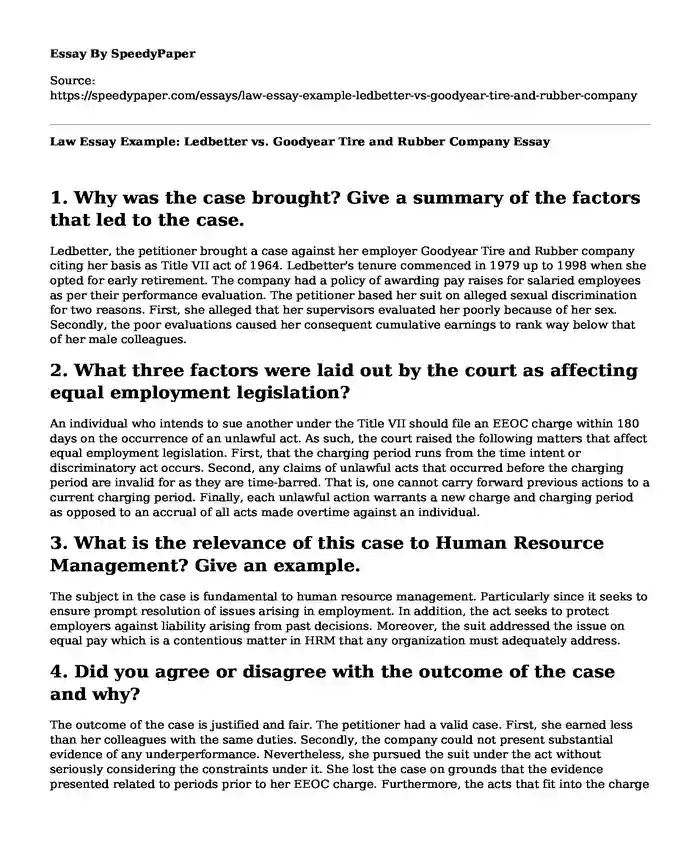
| Type of paper: | Course work |
| Categories: | Employment law |
| Pages: | 2 |
| Wordcount: | 466 words |
1. Why was the case brought? Give a summary of the factors that led to the case.
Ledbetter, the petitioner brought a case against her employer Goodyear Tire and Rubber company citing her basis as Title VII act of 1964. Ledbetter's tenure commenced in 1979 up to 1998 when she opted for early retirement. The company had a policy of awarding pay raises for salaried employees as per their performance evaluation. The petitioner based her suit on alleged sexual discrimination for two reasons. First, she alleged that her supervisors evaluated her poorly because of her sex. Secondly, the poor evaluations caused her consequent cumulative earnings to rank way below that of her male colleagues.
2. What three factors were laid out by the court as affecting equal employment legislation?
An individual who intends to sue another under the Title VII should file an EEOC charge within 180 days on the occurrence of an unlawful act. As such, the court raised the following matters that affect equal employment legislation. First, that the charging period runs from the time intent or discriminatory act occurs. Second, any claims of unlawful acts that occurred before the charging period are invalid for as they are time-barred. That is, one cannot carry forward previous actions to a current charging period. Finally, each unlawful action warrants a new charge and charging period as opposed to an accrual of all acts made overtime against an individual.
3. What is the relevance of this case to Human Resource Management? Give an example.
The subject in the case is fundamental to human resource management. Particularly since it seeks to ensure prompt resolution of issues arising in employment. In addition, the act seeks to protect employers against liability arising from past decisions. Moreover, the suit addressed the issue on equal pay which is a contentious matter in HRM that any organization must adequately address.
4. Did you agree or disagree with the outcome of the case and why?
The outcome of the case is justified and fair. The petitioner had a valid case. First, she earned less than her colleagues with the same duties. Secondly, the company could not present substantial evidence of any underperformance. Nevertheless, she pursued the suit under the act without seriously considering the constraints under it. She lost the case on grounds that the evidence presented related to periods prior to her EEOC charge. Furthermore, the acts that fit into the charge period could not materialize into substantial evidence to justify prior actions. As such, she could not win the case and should have sought a different act or law for redress that better suit the matter at hand.
Reference
Ledbetter v. Goodyear Tire & Rubber Co., Inc., 550 U.S. 618, 127 S. Ct. 2162, 167 L. Ed. 2d 982, 2007 U.S. LEXIS 6295 - CourtListener.com. (2018). Retrieved from https://www.courtlistener.com/opinion/145727/ledbetter-v-goodyear-tire-rubber-co-inc/
Cite this page
Law Essay Example: Ledbetter vs. Goodyear Tire and Rubber Company. (2022, Sep 06). Retrieved from https://speedypaper.com/essays/law-essay-example-ledbetter-vs-goodyear-tire-and-rubber-company
Request Removal
If you are the original author of this essay and no longer wish to have it published on the SpeedyPaper website, please click below to request its removal:
- Food and Health Essay Samples
- Essay Sample: Goods Sale Contract
- Comparison Essay Sample on Robert Frost and Langston Hughes Poems
- Free Essay: Ethical Implications of Implementing Spirituality into Therapy
- Essay Example about Federalism and Constitutional Debates
- Critical Essay Sample on Shakespeare's Midsummers Night Dream
- Paper Example. The Law on Penalties
Popular categories




